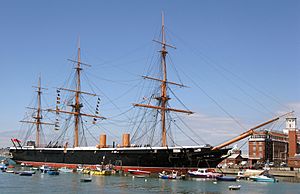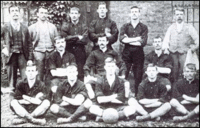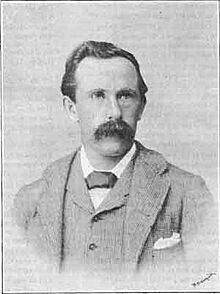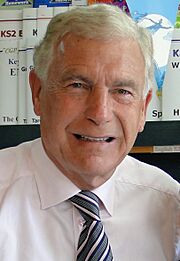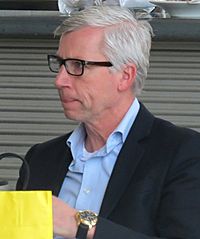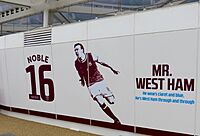History of West Ham United F.C. facts for kids
West Ham United Football Club is a professional football team based in Stratford, in east London. They used to play their home games at the Boleyn Ground in Upton Park from 1904 to 2016. Now, they play at the London Stadium, starting from the 2016–17 season.
The club's history goes back to 1900 when it became a professional team. But even before that, for about five years, it was known as Thames Ironworks F.C.. This team itself grew from an even older club called Old Castle Swifts F.C., formed in 1892.
West Ham first played in the London League, winning it in 1897–98. They then joined the Southern League and Western League, winning the Western League in 1907–08. In 1919, they joined the big Football League. Their first season in the top division was 1923, and they've always stayed in the top two divisions since then.
The Hammers have won the FA Cup three times: in 1964, 1975, and 1980. They were also runners-up twice, in 1923 and 2006. In Europe, they won the European Cup Winners Cup in 1965 and were runners-up in the same competition in 1976. West Ham also won the Intertoto Cup in 1999.
They were the first winners of the War Cup in 1940. Their best finish in the top league was third place in 1986. West Ham have been runners-up twice in the Football League Cup (in 1966 and 1981) and shared the Charity Shield in 1964. In 1965, they received the BBC Sports Personality of the Year Team Award for their European Cup Winners Cup win.
Contents
- How West Ham United Started
- West Ham United Under Syd King (1900–1932)
- West Ham United Under Charlie Paynter (1932–1950)
- West Ham United Under Ted Fenton (1950–1962)
- West Ham United Under Ron Greenwood (1962–1974)
- West Ham United Under John Lyall (1974–1989)
- The Macari and Bonds Eras (1989–1994)
- West Ham United Under Harry Redknapp (1994–2001)
- West Ham United Under Glenn Roeder (2001–2003)
- West Ham United Under Alan Pardew (2003–2006)
- West Ham United Under Alan Curbishley (2006–2008)
- West Ham United Under Gianfranco Zola (2008–2010)
- West Ham United Under Avram Grant (2010–2011)
- West Ham United Under Sam Allardyce (2011–2015)
- West Ham United Under Slaven Bilić (2015–2017)
- West Ham United Under David Moyes (First Spell) (2017–2018)
- West Ham United Under Manuel Pellegrini (2018–2019)
- West Ham United Under David Moyes (Second Spell) (2019–Present)
How West Ham United Started
The football club's beginnings are linked to the shipbuilding industry in Blackwall and Canning Town. This connection is a big part of West Ham's story. Sadly, many old records were lost when a bomb hit the Boleyn Ground in 1944.
Shipbuilding Roots of the Club
West Ham United grew from the Thames Ironworks, a large shipbuilder on the Thames. Their main site was where the Lea meets the Thames. The company started in Blackwall and expanded to Canning Town.
The Thames Ironworks built many ships, including the famous HMS Warrior. However, by the early 1900s, the company found it hard to compete with shipyards in the north of England. They closed down in 1912. Some of their ships, like HMS Thunderer, fought in the Royal Navy during World War I.
From Castle Swifts to Thames Ironworks
The first team that led to West Ham United was called Old Castle Swifts F.C.. It was formed in 1892 by Donald Currie of the Castle Shipping Line. This was the first professional football team in Essex. Players were paid extra to play for the team.
The team won the 1892–93 West Ham Charity Cup. In 1894, they joined with another team, Old St Lukes, and became Old Castle Swifts. By 1895, Donald Currie stopped funding the club, and it went bankrupt.
This is when Arnold Hills stepped in. He was a local business owner and loved sports. He took over the lease of their ground, Hermit Road, and brought some of the players into his new club. One of these players was Robert Stevenson, who became the new club's first captain.
Thames Ironworks F.C. (1895–1900)
The club was officially founded in 1895 as Thames Ironworks F.C.. It was started by Arnold Hills, the company chairman, and Dave Taylor, a works foreman. They wanted to improve morale after some difficult strikes.
Arnold Hills was a big supporter of sports and healthy living. He already sponsored other sports teams and wanted to create a football team for the workers. He made funds available and provided the club's first kit, which was all navy blue. The team played on an amateur basis at first, meaning players were not paid to play football. Many players were employees of the ironworks.
The team played its first competitive game against Chatham Town on 12 October 1895, losing 5–0. They joined the London League in 1896 and finished as runners-up.
In October 1896, the team had to leave their Hermit Road ground and moved to Browning Road. This new ground wasn't ideal. So, Arnold Hills personally funded the development of a new, larger venue called the Memorial Grounds. This place was for all Thames Ironworks sports and the wider community.
Thames Ironworks became a professional team when they joined the Southern League Second Division in 1898. They won the Southern League title in their first try and were promoted. The club was becoming a strong, competitive team.
West Ham United Under Syd King (1900–1932)
Becoming West Ham United (1900–1920)
In June 1900, Thames Ironworks was closed down. But it was immediately restarted on 5 July 1900, with a new name: West Ham United Football Club. The club and its fans are still called "The Irons" and "The Hammers" because of this original connection.
The new club played at the Memorial Grounds. In 1901–02, Syd King became the club secretary and later the manager in May 1902. The club faced financial challenges, leading them to look for a new home.
In 1904, West Ham moved to the Boleyn Ground, also known as Upton Park. This new stadium was built on the site of an old Tudor castle, which is why it was named after Anne Boleyn. Their first game there was against local rivals Millwall, which West Ham won 3–0. This marked the beginning of a long-standing rivalry between the two clubs.
In 1907, West Ham won the Western League Division 1B Championship.
Reaching the Top League (1920–1930)
Under Syd King's leadership, West Ham joined the the Football League Second Division in 1919. They were promoted to the top division in 1923.
In 1923, the club played in the first-ever FA Cup held at the new Empire Stadium, also known as "Wembley." This final is famous for the huge crowd and for "Billie," a horse, ridden by a police officer, who had to clear the pitch before the game could start. This is why it's called "The White Horse Final". West Ham lost 2–0 to Bolton Wanderers.
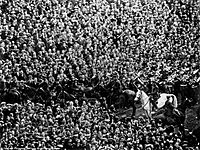
Around the late 1920s, West Ham fans started singing the song "I'm Forever Blowing Bubbles" before home games. This song became the club's anthem, and fans are sometimes called "Bubble Blowers."
West Ham United Under Charlie Paynter (1932–1950)
Syd King left the club in 1932, and Charlie Paynter, who had been with the club for over 35 years, became manager. West Ham was relegated to Division 2 that year.
Paynter focused on developing young players from the club's youth system rather than buying many players from other teams. His plans were disrupted by World War II, as many players were called up for service. Despite the war, football continued. West Ham won the first War Cup in 1940, beating Blackburn Rovers 1–0. The club spent most of the next 20 years in Division 2.
West Ham United Under Ted Fenton (1950–1962)
Ted Fenton became West Ham's manager in 1950. He had played for the club before. Fenton was known for his modern ideas. He pushed for the creation of "The Academy," a system to bring talented young players through the club. This was important because the club had limited money for new signings.
Fenton was inspired by the successful Hungarian team of the 1950s. He encouraged players to discuss tactics and even changed their diet before games. He also encouraged players to get coaching qualifications. Many of his former players went on to become coaches and managers themselves.
West Ham slowly improved during the 1950s. They finally achieved promotion back to the top division in 1958, thanks to goals from John Dick. This period laid the foundation for future successes.
West Ham United Under Ron Greenwood (1962–1974)
Ron Greenwood became manager in 1962. He led West Ham to their first major trophy in 1964, winning the FA Cup final against Preston North End with a 3–2 victory. The success continued a year later when they won the European Cup Winners Cup 2–0 against 1860 München at Wembley.
The most successful team during this time featured three England international players: captain Bobby Moore in defence, Martin Peters in midfield, and Geoff Hurst up front. All three came through the club's youth system. Moore, a brilliant defender, became England captain. Peters was a versatile midfielder, and Hurst was a prolific striker. These three players were key members of England's 1966 World Cup-winning team.
Greenwood's team also reached the League Cup final in 1966 but lost to West Bromwich Albion. Over the next few seasons, Greenwood brought in more talented young players like Billy Bonds, Trevor Brooking, and Frank Lampard Sr.. These players would become club legends. Ron Greenwood later became the manager of the England national team in 1977.
West Ham United Under John Lyall (1974–1989)
John Lyall, a former youth player, took over as manager after Greenwood. In his second season, 1975–76, West Ham reached another UEFA Cup Winners' Cup final but lost 4–2 to Anderlecht.
In 1978, the club was relegated to the Second Division. However, Lyall stayed on. In 1980, while still in the Second Division, West Ham achieved a remarkable FA Cup victory, beating a strong Arsenal team 1–0. This was a rare feat for a team outside the top division. Trevor Brooking scored the winning goal. This 1980 FA Cup remains West Ham's most recent major trophy.
Lyall's team included players like Alvin Martin, Geoff Pike, Paul Allen, Alan Devonshire, and Ray Stewart. In 1981, they were runners-up in the League Cup. West Ham achieved their highest league finish of third place in 1986. Lyall was sacked in 1989 after 15 years, making him the longest-serving manager in the Football League at the time.
The Macari and Bonds Eras (1989–1994)
Billy Bonds, a long-serving club legend, became manager after Lou Macari resigned. Bonds led West Ham to promotion back to the First Division in 1990–91. However, they struggled in the top flight and were relegated in 1991–92, missing the first season of the new Premier League.
The team quickly bounced back, finishing runners-up in Division One in 1992–93 and securing promotion to the Premier League. Key players during this period included Trevor Morley and Julian Dicks.
However, tensions grew between Bonds and assistant manager Harry Redknapp, especially regarding player transfers. Bonds eventually resigned from the club.
West Ham United Under Harry Redknapp (1994–2001)
Harry Redknapp became West Ham manager in 1994. He immediately brought back popular striker Tony Cottee and signed other players like Don Hutchison and Julian Dicks. The team surprised many by finishing 13th in their first Premier League season.
Redknapp focused on strengthening the defence, signing international centre-backs like Marc Rieper and Slaven Bilić. West Ham improved to tenth place in 1995–96.
The "Bosman ruling" changed football rules, allowing Redknapp to sign more foreign players. He brought in players like Florin Răducioiu and Paulo Futre, though these signings didn't always work out. The team struggled in 1996–97 due to injuries and poor performances.
To avoid relegation, the club signed strikers John Hartson and Paul Kitson, who helped the team survive. The following season, 1997–98, Redknapp added Eyal Berkovic and Trevor Sinclair. Young players like Rio Ferdinand and Frank Lampard also started to shine. The team finished eighth.

In 1998–99, Redknapp signed experienced players like Ian Wright and Neil Ruddock, and goalkeeper Shaka Hislop. After some issues, the club signed Paolo Di Canio, who became a fan favourite. West Ham achieved a fifth-place finish, which earned them a spot in the UEFA Intertoto Cup. They won this competition, qualifying for the UEFA Cup, ending a nearly 20-year absence from European football.
The 1999–2000 season saw the introduction of future stars Joe Cole and Michael Carrick to the first team.
Redknapp's final season was 2000–01. The club sold their star player, Rio Ferdinand, to Leeds United for a British transfer record fee. Redknapp's relationship with the board broke down, and he was sacked before the end of the season. After his departure, Frank Lampard Jr. was sold to Chelsea.
West Ham United Under Glenn Roeder (2001–2003)
Glenn Roeder, the youth team manager, was appointed manager in 2001. West Ham had a slow start to the 2001–02 season due to injuries. Roeder signed respected defender Tomáš Řepka and Don Hutchison. Despite early pressure, he guided the club to a seventh-place finish.
The 2002–03 season was difficult. Injuries to key players like Frédéric Kanouté and Paolo Di Canio hurt the team. Roeder collapsed in his office in April 2003 and was diagnosed with a brain tumour. Trevor Brooking took over for the final three games. Despite an improvement in form, West Ham finished 18th and were relegated from the Premier League after ten years.
The relegation led to the sale of many promising young players, including Joe Cole, Glen Johnson, Frédéric Kanouté, and Jermain Defoe. Roeder was sacked early in the 2003–04 season.
West Ham United Under Alan Pardew (2003–2006)
Alan Pardew was appointed manager with the goal of getting West Ham back into the Premier League. He brought in many new players, including Marlon Harewood, Matthew Etherington, Hayden Mullins, and Bobby Zamora.
In his first season, 2003–04, West Ham finished fourth in the Championship but lost in the play-off final to Crystal Palace. The following year, 2004–05, they secured promotion through the play-offs, beating Preston North End 1–0 in the final with a goal from Bobby Zamora.
Back in the Premier League for 2005–06, West Ham exceeded expectations, finishing in the top half. They also had a great FA Cup run, reaching the final. They beat Arsenal away from home for the first time since 1995. In the FA Cup semi-final, they defeated Middlesbrough 1–0.
The FA Cup final was against Liverpool. West Ham took a two-goal lead but the game ended 3–3. West Ham eventually lost 3–1 on penalties in a memorable final.
At the start of the 2006–07 season, star striker Dean Ashton broke his ankle while on international duty. On transfer deadline day, West Ham surprised everyone by signing two promising young Argentinian players, Carlos Tevez and Javier Mascherano.
West Ham's return to European competition in the 2006–07 UEFA Cup was short-lived. They struggled in the league, and after a poor run of results, Alan Pardew was sacked in December 2006.
West Ham United Under Alan Curbishley (2006–2008)

Former West Ham player Alan Curbishley took over as manager in December 2006. He made an impressive start, winning his first game against Manchester United.
In January 2007, with the team struggling, Curbishley signed new players like Luís Boa Morte, Nigel Quashie, Calum Davenport, and Lucas Neill. The team's performances improved greatly in the final weeks of the season. West Ham won seven of their last nine games, including a crucial 1–0 win against Manchester United at Old Trafford on the final day. This victory secured their Premier League survival.
Curbishley continued to rebuild the squad in the summer of 2007, bringing in players like Scott Parker, Kieron Dyer, and Craig Bellamy. The 2007–08 season saw West Ham finish comfortably in tenth place.
In the 2008–09 season, Curbishley resigned and was replaced by Gianfranco Zola.
West Ham United Under Gianfranco Zola (2008–2010)

Despite a difficult start, West Ham finished in a comfortable mid-table position in Gianfranco Zola's first season. The club faced financial challenges, which made it hard for Zola to strengthen the squad.
The 2009–10 season started well but then the club struggled, finding themselves in the relegation zone. In January 2010, former Birmingham City co-owners David Gold and David Sullivan, both West Ham fans, took control of the club.
Results improved slightly, and West Ham managed to avoid relegation, finishing 17th in the Premier League. However, Zola's contract was ended in May 2010.
West Ham United Under Avram Grant (2010–2011)
Avram Grant was appointed manager in June 2010. He signed several new players, including Thomas Hitzlsperger, Pablo Barrera, and Frédéric Piquionne. The team struggled to win games early in the season.
Despite some improved results in December and January, West Ham remained at the bottom of the league. In May 2011, West Ham's relegation to the Championship was confirmed after a loss to Wigan. Grant was sacked immediately after the game.
West Ham United Under Sam Allardyce (2011–2015)
Sam Allardyce became manager in June 2011. He quickly brought in players he knew, like Kevin Nolan and Joey O'Brien. In his first season, 2011–12, West Ham finished third in the Championship and entered the play-offs.

In May 2012, West Ham won the 2012 Football League Championship play-off final, securing promotion back to the Premier League after just one season in the Championship.
For the 2012–13 season, Allardyce signed 11 new players, including Andy Carroll and James Collins. A highlight was a 3–1 home win against European champions Chelsea. West Ham finished tenth in the league. In March 2013, the club secured a 99-year lease for the London Olympic Stadium, planning to move there for the 2016–17 season.
In 2013–14, West Ham broke their transfer record again, signing Andy Carroll permanently for £15 million. Despite a poor start, a run of four wins in February helped them pull away from the relegation zone. They finished 13th.
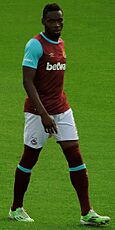
The 2014–15 season started well, with victories against Manchester City and Liverpool. However, the team's form declined in the second half of the season. They finished 12th, and Allardyce announced his departure immediately after the final game.
West Ham United Under Slaven Bilić (2015–2017)
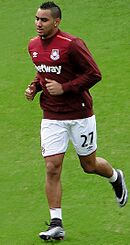
In June 2015, former player Slaven Bilić was appointed manager. His first game was a 3–0 home win in the Europa League. Sixteen-year-old Reece Oxford became the youngest-ever player to play for West Ham in this game.
New signings for 2015–16 included Angelo Ogbonna, Dimitri Payet, and Manuel Lanzini. West Ham started the Premier League season with a surprising 2–0 away win against Arsenal. They also achieved their first win at Liverpool's Anfield since 1963. West Ham finished 7th in the Premier League, qualifying for the 2016–17 Europa League.
After a series of poor results, Bilić was sacked in November 2017.
West Ham United Under David Moyes (First Spell) (2017–2018)
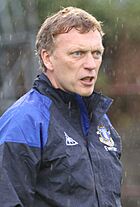
David Moyes was appointed manager in November 2017. He changed the team's formation, which helped striker Marko Arnautović score many goals. West Ham finished 13th in the Premier League.
After securing their Premier League place, Moyes left the club after six months. His time was marked by some fan protests against the club's board and the move to the Olympic Stadium.
West Ham United Under Manuel Pellegrini (2018–2019)
In May 2018, Manuel Pellegrini signed a three-year contract. He had previously won the Premier League title with Manchester City. West Ham spent a lot of money on new players, breaking their transfer record twice for Issa Diop and Felipe Anderson. They also signed players like Łukasz Fabiański and Andriy Yarmolenko. West Ham finished 10th in Pellegrini's first season.
2019–2020 Season
At the start of the 2019–20 season, West Ham broke their transfer record again, signing Sébastien Haller for £45 million. They also signed Pablo Fornals. The season started well, but then the team's form declined. After a poor run of results, Pellegrini was sacked in December 2019.
West Ham United Under David Moyes (Second Spell) (2019–Present)
David Moyes was reappointed as manager in December 2019. West Ham won his first game back, a 4–0 home win against Bournemouth. The season was interrupted by the COVID-19 pandemic. When it restarted, West Ham managed to avoid relegation, finishing 16th.
Ahead of the 2020–21 season, the club's ownership faced criticism from fans and captain Mark Noble. Despite this, West Ham had a fantastic season, finishing 6th in the Premier League and qualifying for the 2021–22 UEFA Europa League group stages. Moyes signed a new contract in June 2021.
In 2021–22, West Ham continued their success in Europe. They reached the quarter-finals of the Europa League, beating Lyon 3–0 away from home. They then reached their first European semi-final since 1976 but were knocked out by Eintracht Frankfurt. They qualified for the UEFA Europa Conference League by finishing seventh in the league. This season was also notable as the final one for club legend Mark Noble, who retired after 18 years and 550 appearances.
The 2022–23 season was mixed. West Ham finished 14th in the Premier League. However, they had an amazing run in the Europa Conference League. They went unbeaten all the way to the final, winning 13 games and drawing only once. They won the final, defeating Fiorentina 2–1, to claim their first major trophy since 1980 and their first European trophy in 58 years!


